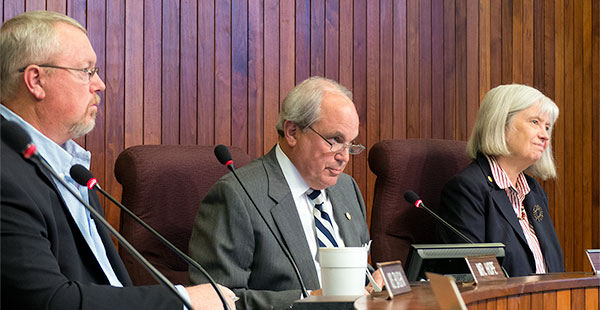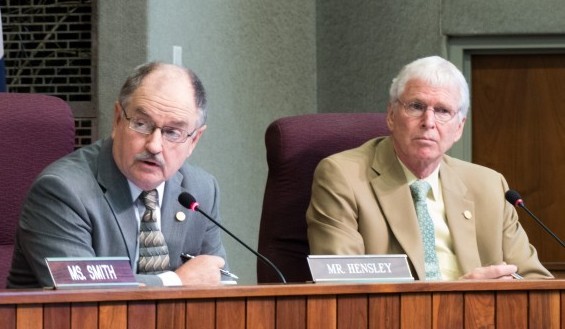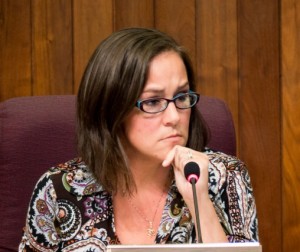
The Oak Ridge Water Treatment Plant is pictured on Pine Ridge above the Y-12 National Security Complex. (Photo by City of Oak Ridge)
Note: This story was updated at 6:50 p.m.
Some Oak Ridge City Council members have questioned whether the federal government is paying enough for municipal water at Oak Ridge National Laboratory and Y-12 National Security Complex, and on Monday, four of them proposed roughly tripling a potential new high-volume water rate at the two federal sites in 2017.
The new water rate would apply to water consumption over 20 million gallons per month, which would limit it to ORNL and Y-12. The two sites use a total of more than 100 million gallons of water per month.
The new rate is expected to go into effect in April 2017 only if Oak Ridge and the U.S. Department of Energy aren’t able to agree on a contract for water at ORNL and Y-12 by the end of March. Those two federal sites now pay a flat annual rate but could default to what is known as a retail rate if the contract lapses.
The city staff had proposed a new default rate of $1.08 per thousand gallons for consumption over 20 million gallons starting January 1, 2017. The following year, in 2018, the staff had proposed a $1.35 rate.
But four City Council members—Rick Chinn, Charlie Hensley, Trina Baughn, and Chuck Hope—voted to raise the $1.08 rate in 2017 to $3 per 1,000 gallons. Oak Ridge Mayor Warren Gooch, Mayor Pro Tem Ellen Smith, and Council member Kelly Callison voted against the increase.
Chinn said there is a huge discrepancy between the DOE rate at ORNL and Y-12, and the average household rate.
For example, the proposed new water rates that were approved by Council in the first of two readings on Monday would have a residential customer who exceeds the minimum 2,000 gallon consumption pay $7.05 per 1,000 gallons for consumption between 3,000 and 10,000 gallons.
Meanwhile, DOE is paying about $1.68 per 1,000 gallons of water, city officials said in March. On Monday, Oak Ridge Finance Director Janice McGinnis said the DOE rate was budgeted at $1.84 in 2017 and $2.10 in 2018.
“They’re getting a really good deal,” Chinn said of the DOE rate.
Chinn made the motion to raise the proposed new rate on consumption over 20 million gallons from $1.08 per 1,000 gallons to $3, twice the current production cost. That’s the rate that could go into effect in 2017 if the city and DOE can’t agree on a new water contract at ORNL and Y-12.
Hensley, who has been critical of the payments in lieu of taxes that DOE pays on its large tracts of land in Oak Ridge, provided a second to Chinn’s motion.
“I’d like to get their attention,” Hensley said.
Hensley has said that Oak Ridge residents are subsidizing the federal operation, and the department is taking advantage of the city. He said he doesn’t think the relationship could get any worse.
Baughn, who has also raised concerns about the DOE rate compared to the average household rate, supported Chinn’s proposal to roughly triple the proposed high-volume rate for ORNL and Y-12.
“No matter how you slice it, put yourself in the average ratepayer’s shoes, and this stinks,” she said Monday. “DOE (at ORNL and Y-12) is paying two (to) three times less for the water…I’m tired of paying so much for water and sewer. I’m tired of seeing it doubled.”
Hope also supported the proposal. He has previously suggested that DOE ought to at least pay whatever it costs the city to make water. He did so again Monday.
In response to questions from Hope, Oak Ridge Finance Director Janice McGinnis said it costs about $1.50 to produce 1,000 gallons of water, although the cost can vary. She said the rate that the city charges DOE is more than or equal to the production cost.
The original DOE rate considered by City Council on Monday, the one that had been proposed by city staff and then increased by Council, was calculated by a consultant to cover 50 percent of the city’s water production costs, McGinnis said.
DOE officials and city staff members have suggested that Council members might not want to directly compare the retail water rates inside the city with the water rates at ORNL and Y-12. That’s because, unlike the city’s retail water customers, ORNL and Y-12 do not pay for distribution costs inside the city.
Those costs include the expenses associated with maintaining and operating a few hundred miles of water lines and pumping systems. Those distribution costs are estimated to be more than half of the total water costs in the city.
ORNL and Y-12 get their water from the Oak Ridge water plant on Pine Ridge above Y-12 and they pay half of the production costs, but the sites have their own separate distribution systems and costs, officials said. When a water line needs repair at ORNL or Y-12, Oak Ridge City Manager Mark Watson told Council members Monday, workers at those sites fix it, and not the City of Oak Ridge.
Council members who voted against the Monday night proposal to about triple the high-volume rate for ORNL and Y-12 in 2017 said they weren’t necessarily opposed to a number higher than $1.08, but they want more information.
Smith, the mayor pro tem, proposed deferring the discussion, saying if municipal officials raise the rate significantly higher than $1.08, DOE might not take the city seriously and the relationship could become more difficult. She said she wanted to be able to discuss the proposal with legal counsel and the city’s rate consultant.
“We’ve been advised in the past that DOE won’t take us seriously if we start suggesting we’re going to charge them a whole lot more than it costs us to provide water to them,” Smith said.
She said the new retail rate was calculated to ensure that, if a contract isn’t reached by early next year, the city could still charge ORNL and Y-12 for water. The new rate is calculated to ensure that the city can get the kind of money it needs to run the part of the water system used to serve DOE, Smith said.
“The fact that these numbers look low is only related to the fact that they use a huge amount of water and they maintain their own distribution system instead of ours,” Smith said. “They’ll still be our biggest customer.”
Gooch, the city’s mayor, said the rate could possibly be raised, but he wants more information on the true rate structure.

Pictured above at the Oak Ridge City Council meeting on Monday, Sept. 14, 2015, are Council members Chuck Hope, left, Mayor Warren Gooch, and Mayor Pro Tem Ellen Smith. (File photo by John Huotari/Oak Ridge Today)
After they amended the rate increases to roughly triple the high-volume water rate for ORNL and Y-12 in 2017, Council members voted 5-2 for the water and wastewater rate increases. Baughn and Callison, who did not support the larger rate increase for ORNL and Y-12 in 2017, voted “no.”
During a discussion with McGinnis, Callison had confirmed that there was an economic basis for the staff’s proposed 20-million-gallon rate for DOE, the rate that had been proposed at $1.08 per 1,000 gallons but was increased by Council members to $3 in 2017.
Monday’s vote on the water and wastewater rate increases, which also apply to homes and businesses in Oak Ridge, was the first of two votes, or readings. The second vote is expected in October.
The proposed increases would raise water and sewer rates by 6 percent starting January 1, 2017. The next year, effective January 1, 2018, a 4 percent increase has been proposed for water rates and a 6 percent increase has been proposed for sewer rates.
A home that uses the minimum amount would pay an extra $2.26 per month for water and sewer starting in 2017 and an additional $2.17 per month in 2018.
A home that uses 5,000 gallons per month would pay $5.33 more per month for both water and sewer in 2017 and another $4.87 in 2018.
McGinnis has said the rate increases are required to continue to operate and maintain the systems, perform necessary capital improvements, and meet contractual and debt service obligations.
The water rates being discussed at ORNL and Y-12 are different from the rates paid at other DOE sites, such as the Oak Ridge Office and East Tennessee Technology Park. Those sites pay what is known as a retail rate. That’s a rate like residents pay, and the rate can vary depending upon a few factors, including monthly consumption.
The public discussion over the DOE rates started in March, when City Council approved a one-year, $2.1 million contract extension for water supplied to ORNL and Y-12. The fixed-rate extension was approved in a 4-2 vote, and it is for up to 1,619,000,000 gallons of water at ORNL and Y-12 through March 31, 2017.
The one-year water contract extension was expected to give the city time to have a qualified third-party engineering firm study the city’s aging water plant on Pine Ridge, consider what is needed, and develop options that could help Oak Ridge decide whether to renovate the 70-year-old facility—or build a new one at a new site.
On Monday, Oak Ridge City Attorney Ken Krushenski said the contractual agreement between the city and ORNL and Y-12 started with the city’s takeover of the water plant in 2000. If the city and DOE can’t agree on rates, DOE could reclaim the plant, Krushenski said.
“Great!” Hensley responded.
Officials have previously said that turning the water plant back over to DOE would make the city the rate payer, and it would mean DOE would set water rates.
Earlier this year, Oak Ridge officials said a residential water system like the city’s is different than a large consumer system like DOE’s system at ORNL and Y-12. There is a higher cost per unit in a residential system than in a large consumer system, Watson said. The large consumer system has large pipes moving water, while the residential system has small pipes with electricity-consuming pumps that move water up and down the hills of the city, he said.
A study presented to City Council in 2013 anticipated water and sewer rate increases on January 1 each year through fiscal year 2019, starting in January 2014. That was based on capital and debt service requirements, operating expenses, and inflation, among other funding considerations, McGinnis said.
Rate increases planned for January 2016 were delayed to January 2017, so the expected rate increases from 2016 to 2019 would be extended one year to 2017 through 2020.
There will be a rate review conducted in the summer of 2017.
McGinnis said Oak Ridge water rates are on the high side among surrounding municipal utility districts, although they are lower than some nearby rural utility districts. Oak Ridge’s system is residential-based and doesn’t have a lot of industry that is using water, McGinnis said.
More information will be added as it becomes available.

Oak Ridge City Council members Charlie Hensley, left, and Kelly Callison are pictured above during a Sept. 14, 2015, meeting. (File photo by John Huotari/Oak Ridge Today)
Do you appreciate this story or our work in general? If so, please consider a monthly subscription to Oak Ridge Today. See our Subscribe page here. Thank you for reading Oak Ridge Today.
Copyright 2016 Oak Ridge Today. All rights reserved. This material may not be published, broadcast, rewritten, or redistributed.


Joseph Lee says
It’s time to focus on the water rates and plant.
Philip W Nipper says
I wonder if rather than attempting to increase the rates Y-12 and ORNL pay for water if council should not focus their attention and efforts on getting DOE to help, in a large way, pay for the essential repairs and improvements to the water plant that are desperately needed. To me, that is the battle that should be fought and in the end would be a greater win for the city.
Joseph Lee says
I agree Mr. Nipper. The condition of the water plant is the key for everyone that uses water in this town and everyone needs water. The water rate is meaningless if the plant is not in the condition where it can safely, efficiently and reliably produce it. I am looking forward to seeing the engineer’s report on the plant and the options presented to resolve this issue. To fix this problem it’s going to cost some real dollars. The question is: who pays and how much?